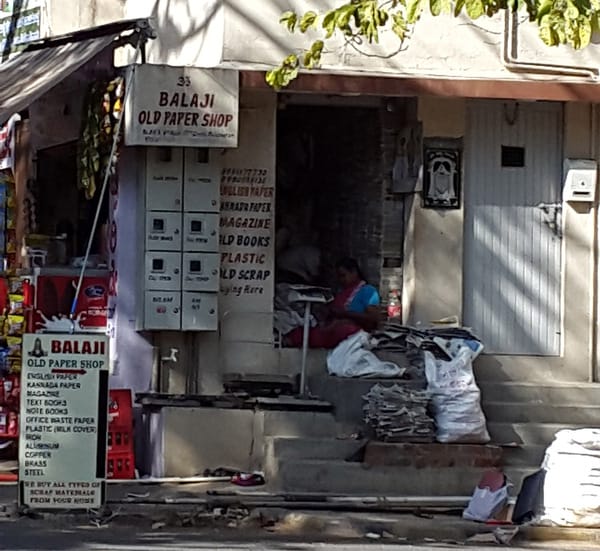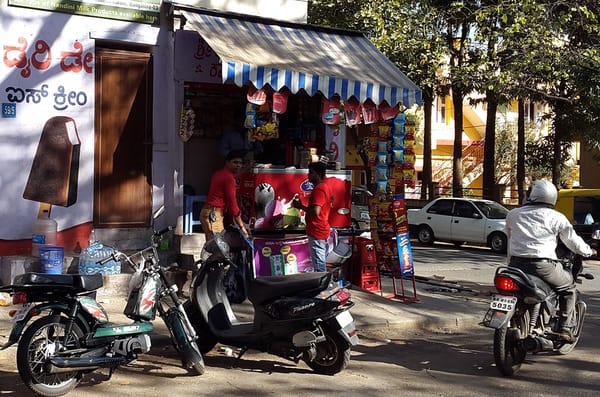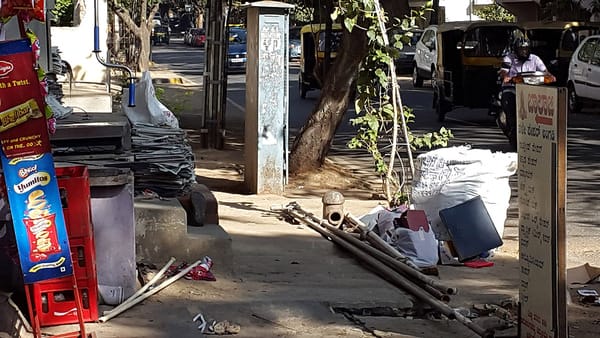As I walk to work, I pass by one of the intersections on 17th Cross every day. This is a one way road and therefore attracts a good amount of traffic. Luckily the road has still retained its old charm and has not deteriorated into the chaos that is 15th cross.
In the last few months, a house that stood at the intersection has been undergoing renovations. I did not pay much attention to it till it was completed. There is so much building and re-building happening in Malleshwaram that unless it is the demise of a grand old house, or the cutting of some grand old trees, one gets inured to it. Once it was finished, I noticed that the owner had cleverly created three spaces to rent out on the ground floor. One was barely two feet deep, and that became a snack stall. The other was somewhat deeper and broader, and that became a dress boutique. It’s the third space that bothered me the most. It was narrow and deep, and I guess perfect for the person who was going to occupy it – a ‘raddi’ shop or a used paper vendor. The chap also sold all sorts of other old stuff apart from newspapers, like cardboard boxes, old pipes and metal items.

Pic: Suchitra Deep
Now, I think these sorts of places are an integral part of our lives and I have nothing against them. In fact I think the used paper vendors perform an important task for us, so I am totally in favour of them being around. But what bothered me was the manner in which both the snack stall and the used paper vendor used the space.
Let’s start with the snack guy. He sells snacks, ice cream, and tea and coffee by the cup. I have had to request him several times to keep a dustbin handy so that waste can be disposed neatly into the bin. He has placed a small dustbin that is only suitable for domestic use on one side. This gets easily filled up by evening, and then the rest of the trash ends up on the street. Scooters, bikes, and sometimes even cars are parked haphazardly on the road in front of the stall, and this makes the junction more dangerous to traverse. In the morning, the sweeper sweeps the place clean of all trash, but by evening, it is a sorry sight with cups and wrappers strewn around the entire area once again.

Pic: Suchitra Deep
Around the corner, the used paper vendor has stacked papers and boxes and other trash on the pavement, blocking access to that part of the pavement. There is a fetid stench that emanates from the shop whenever I pass by. When I told the vendor that he cannot block the pavement with his material, he said with alacrity, “I am doing my business here, I have every right to occupy the space.” I tried to reason with him that this was public property and therefore, not really his sole domain. But of course, my arguments have fallen on deaf ears. So every day, as I pass by that junction, I see rubbish strewn everywhere and scrap material piled up on the pavement. No one seems particularly bothered, and I don’t see anyone complaining about it.

Pic: Suchitra Deep
To me however, these are precursors to something more insidious that is happening inside residential areas everywhere, and I think there are important questions that one needs to ask. When a residential area gets used for commercial purposes, what are the ‘unwritten’ rules that they must follow? Should the landlords use their own judgment to decide what uses they could put their rental space to? Or should there be restrictions on having such establishments in a residential area? Does the negotiable nature of public space make it open to abuse? Can littering or misuse of public space be ignored or even encouraged because it is ‘nobody’s problem’? If such problems occur, what is the recourse?